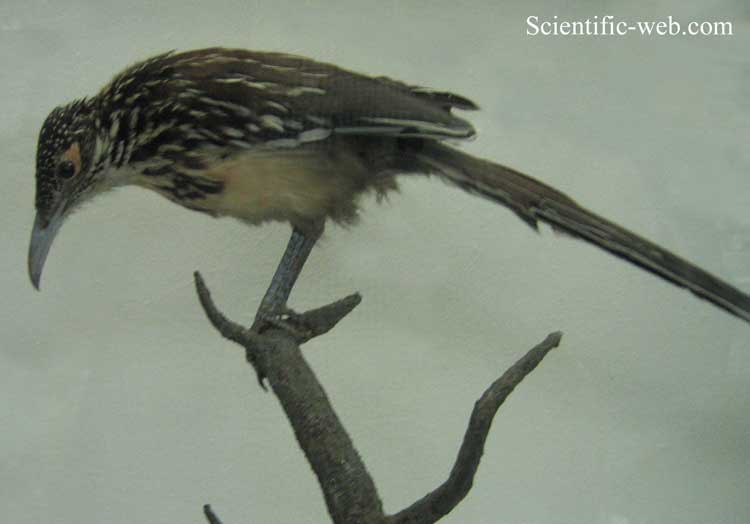Geococcyx californianus, Photo: Michael Lahanas Cladus: Eukaryota Name Geococcyx californianus (Lesson, 1829) Reference Oeuvres completes de Buffon 6 p.420 Vernacular names The Greater Roadrunner, taxonomically classified as Geococcyx californianus, meaning "Californian Earth-cuckoo," is a long-legged bird in the cuckoo family, Cuculidae. It is one of the two roadrunner species in the genus Geococcyx; the other is the Lesser Roadrunner. This roadrunner is also known as the chaparral cock, ground cuckoo, and snake killer.[2] Description
The name roadrunner comes from the bird's habit of racing down roads in front of moving vehicles and then darting to safety in the brush. Habitat The breeding habitat is desert and shrubby country in the southwestern United States and northern Mexico. It can be seen in the US states of California, Arizona, New Mexico, Texas, Nevada, Utah, Colorado, Oklahoma, and rarely in Kansas, Louisiana, Arkansas and Missouri,[2] as well as the Mexican states of Baja California, Baja California Sur, Sonora, Sinaloa, Chihuahua, Durango, Jalisco, Coahuila, Zacatecas, Aguas Calientes, Guanajuato, Michoacán, Querétaro, México, Puebla, Nuevo León, Tamaulipas, and San Luis Potosí.[3] Behavior The Greater Roadrunner nests on a platform of sticks low in a cactus or a bush and lays 3–6 eggs, which hatch in 20 days. The chicks fledge in another 18 days. Pairs may occasionally rear a second brood. Greater Roadrunners measure 61 cm (2 feet) in length, about half of which is tail. They have long, wobbly legs and a slender, pointed bill. The upper body is mostly brown with black streaks and sometimes pink spots. The neck and upper breast are white or pale brown with dark brown streaks, and the belly is white. A crest of brown feathers sticks up on the head, and a bare patch of orange and blue skin lies behind each eye;[4] the blue is replaced by white in adult males (except the blue adjacent to the eye), and the orange (to the rear) is often hidden by feathers.[2] This bird walks around rapidly, running down prey or occasionally jumping up to catch insects or birds. It mainly feeds on insects, with the addition of small reptiles (including rattlesnakes up to 60 cm long), rodents and other small mammals, spiders, scorpions, centipedes, millipedes, small birds (particularly from feeders and birdhouses) and eggs, and carrion. It kills larger prey with a blow from the beak—hitting the base of the neck of small mammals—or by holding it in the beak and beating it against a rock. Two roadrunners sometimes attack a relatively big snake cooperatively. Fruit and seeds typically constitute about 10% of the diet.[2] Although capable of flight, it spends most of its time on the ground, and can run at speeds of up to 20 miles per hour (32 km/h).[4] Some Pueblo Indian tribes, such as the Hopi, believed that the roadrunner provided protection against evil spirits. In Mexico, some said it brought babies, as the White Stork was said to in Europe. Some Anglo frontier people believed roadrunners led lost people to trails.[2] It is the state bird of New Mexico. References 1. ^ BirdLife International (2008). Geococcyx californianus. In: IUCN 2008. IUCN Red List of Threatened Species. Downloaded on 1 April 2009. * "Geococcyx californianus". Integrated Taxonomic Information System. http://www.itis.gov/servlet/SingleRpt/SingleRpt?search_topic=TSN&search_value=177836. Retrieved 9 February 2006. Source: Wikipedia, Wikispecies: All text is available under the terms of the GNU Free Documentation License |
|

